After a few days of dodging incessant traffic and fighting pedestrians on cramped sidewalks on the island of Malta, I was in need of some serenity, so I hopped over to Gozo for the day. I felt the shift the moment I stepped off the ferry. Rather than breezes saturated with the smell of stale beer, on Gozo the air was sweet and fresh. Instead of drunks staggering around in the wee hours, tourists on Gozo had flocked to sidewalk cafes to enjoy breakfast and cappuccino in the brilliant morning sunshine.
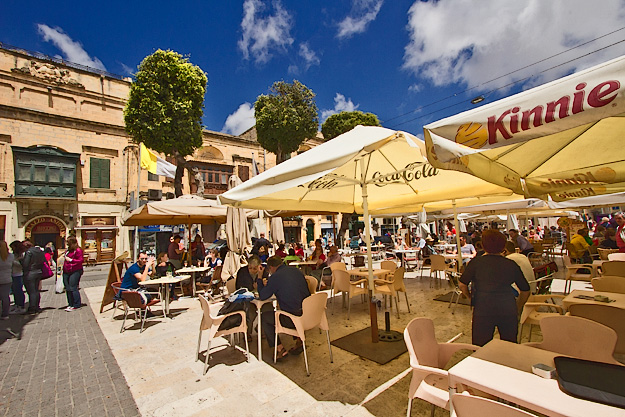
Our van made its way around the island as tour guide, Terry Spiteri, entertained us with stories about Gozitan culture and local traditions.
“Keep your eyes peeled for houses with keys in the front door. This is a long-standing tradition on Gozo. Some say it began during World War II, when the men were away from home fighting for long periods of time. Wives left the keys in the door so that husbands could come home any time of the day or night. Others insist that the women took lovers because the men were away so much, and the key was left in the lock so their paramours could enter as soon as their husbands returned to the battlefield.”
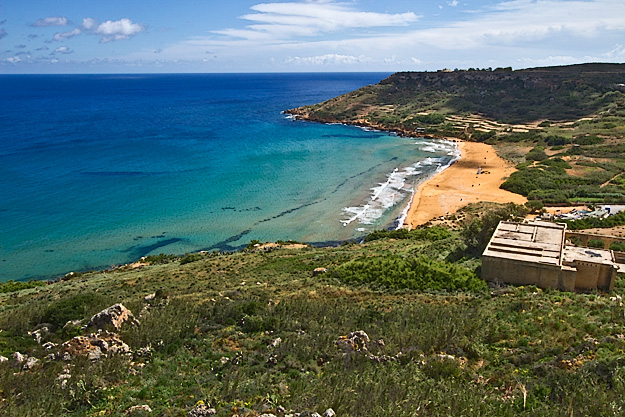
After a brief stop at Calypso Cave, said to be the cave where the beautiful nymph, Calypso, imprisoned Odysseus for seven years, we crossed the island diagonally, cresting and dipping between hills, to the Azure Window. For me, the wave and wind-carved arch in a limestone promontory was much less intriguing than the thousands of fossilized sand dollars embedded in the limestone beneath my feet.
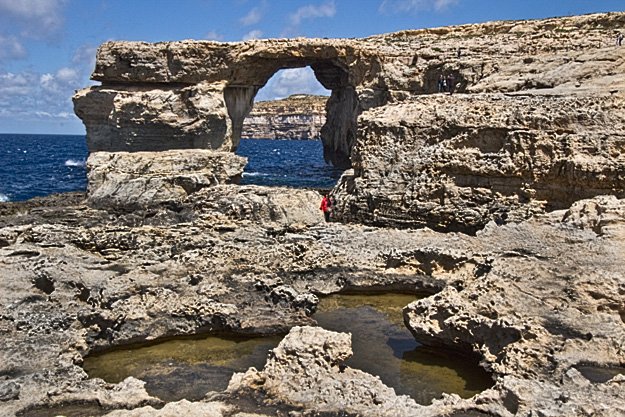
On the opposite side of the bay loomed Fungus Rock, named for a rare flowering parasite used by the Knights of Malta to heal wounds and cure dysentery. So prized was this fungus that the Knights closely guarded the rock and severely punished anyone found trespassing.

Back in the van, Terry continued our introduction to Gozo by explaining the significance Gozian surnames. Some were derived from the three main religions that had shaped the Maltese Islands (Jewish, Islam, and Christianity), while others signified a person’s occupation. Her surname, however, reveals a personal status. Decades ago, all orphans were cared for by hospitals. These orphans were given the surname “Sptar,” the Maltese word for hospital, which gradually became corrupted to Spitari. Today, Spitari is the 14th most used surname in the Maltese Islands. Why so many orphans throughout history? The answer may lie with the Knights of Malta, who had taken a vow of celibacy. Admitting they had fathered a child would have negated their vows; the solution was to abandon the child, knowing it would be cared for by the hospital.
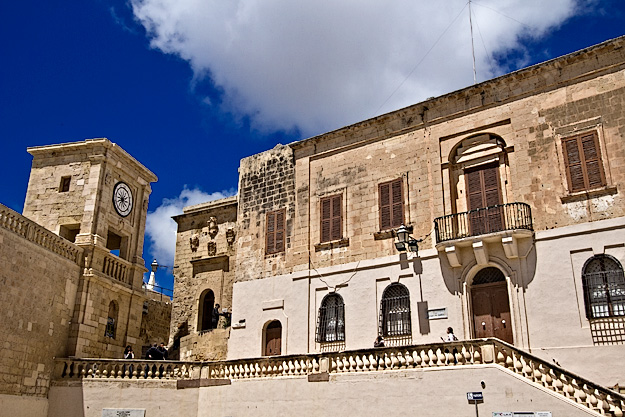
With such fascinating stories to entertain us, the drive to our next stop passed quickly. Soon, we were climbing up to the Citadella, the historic fortified city that sits atop a hill in the capital city of Victoria. There is evidence that the site has been in use since Neolithic times, however the first fortifications were installed by the Phoenicians. Later added to by the Romans, it was largely destroyed by Ottomans who attacked and conquered Gozo in the mid-16th century. By 1599, the Knights of Malta had shrugged off the yoke of the Turks and immediately began rebuilding the Citadella to its current configuration. Today, the exquisite Gozo Cathedral sits at its apex, surrounded by the ancient fortress and its ramparts, which provide views across the entire island.
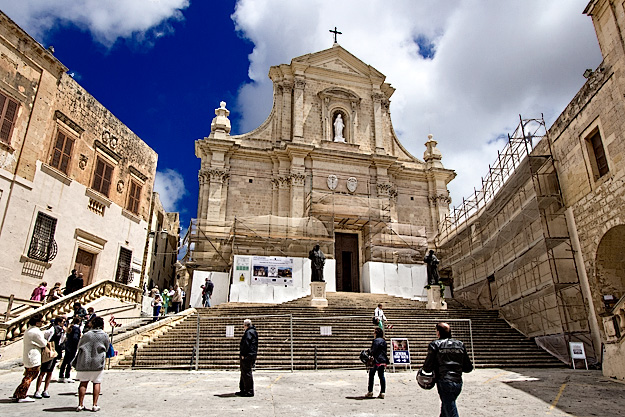
The real treat, however, was inside the cathedral. I was about to leave when a guard at the front door asked me if I had noticed anything unusual about the ‘dome’ in the center of the Latin cross floor plan. When I shook my head no, she insisted upon accompanying me back into the nave, where we both looked up.
“What do you see?” she asked. When I replied that I saw a beautifully painted dome, she told me to look closer. I shook my head and looked at her quizzically. “It’s not a dome.” she explained. “The church ran out of money before they could build one, so instead they had it painted in tromp l’oeil, a technique that creates the illusion of three dimensions. The ceiling is actually flat.”

I thought she was teasing me. I was certain that it was a real dome. She grinned and slowly led me around the center of the floor in a counter-clockwise direction. Sure enough, as we walked it became apparent that the dome was an optical illusion.
It was nearing our meeting time back at the van and I hadn’t seen much of Victoria, so I rushed back down the hill and poked around the city center, admiring the city’s gorgeous architecture. Like Malta, the buildings in Gozo are all constructed from the indigenous limestone and embellished with colorfully painted wooden balconies, although pride of ownership is much more apparent on Gozo.

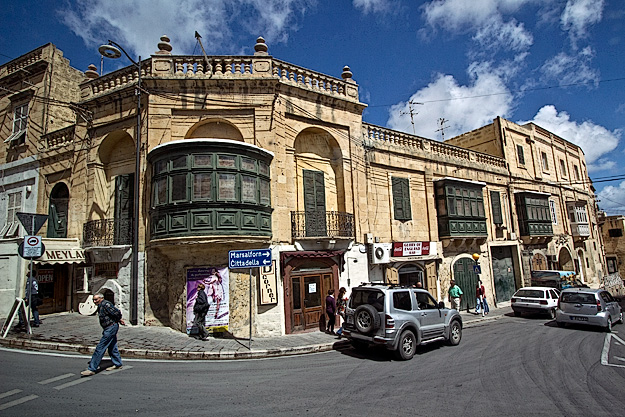
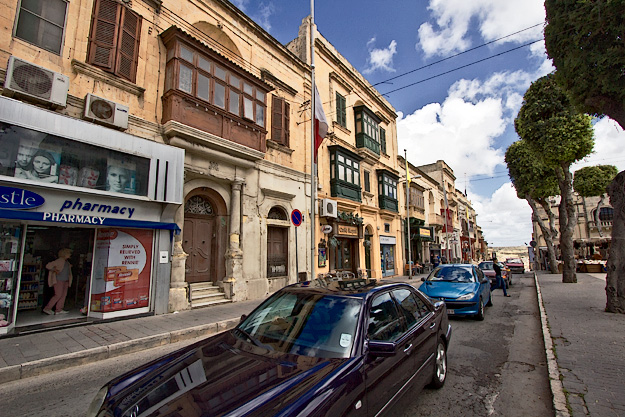
In short order, it was time to leave for Xlende, a small seaside village on the west coast. The character of Gozo remains rural and simple, with a culture rooted in fishing and agriculture. Each time our van crested one of Gozo’s ubiquitous rolling hills, a green and yellow mural of patchwork fields stretched to the sea. Gozo farmers produce most of the produce used in the Maltese Islands, and its blue clay soil produces extraordinarily tasty tomatoes, melons, grapes, figs, and oranges.

I had an opportunity to sample some of that famous Gozo produce at Zafiro Restaurant in Xlende, where I demolished an antipasto platter of local delicacies. I swooned over sun dried tomatoes, roasted onion, and fried artichokes. The eggplant dip brought ears to my eyes. I was getting full, but couldn’t resist the roasted tomatoes, local olives, fava beans, and bruschetta. If only I were a cow, with four stomachs…I would have done it all over again. I sipped my coffee to the sound of gentle waves lapping at the seawall, wondering if the waiter would roll me up the hill to the van if I tipped him well enough. I didn’t want to leave, but had no choice. The ferry waits for no tourist.


On the short sail back to Malta, I mulled over the convoluted history of Gozo. Every occupying culture over the centuries had a name for this island. The Phoenicians called it Gaulos, perhaps a reference to the shape of the island, which resembled a round ship from a distance. Arabs dubbed it Ghawdex. But my favorite is the moniker given it by invaders from Aragon in northeastern Spain; they called it Gozo, which mans ‘joy’ in Castillian. One day is hardly enough to make an informed decision about a destination, but I know this much. I had a joyful day on this tiny speck in the middle of the Mediterranean, and if ever I return to the Maltese Islands, I’ll bypass Malta entirely and head for more mellow Gozo.
Disclosure: I was a guest of ElanGuest English Language School during my stay in the Maltese Islands. However, the receipt and acceptance of complimentary items or services will never influence the content, topics, or posts in this blog. I write the truth, the whole truth, and nothing but the truth.

I am sorry to hear that you consider the Maltese Islands as being small and remote. Small we are and thank God for that but remote???? So many people visit and can afford living is so many tiny islands around the world (the well to do naturally) but Malta is connected worldwide. It is true that you have to travel by air and not have the benefit of choosing either road, rail or car travel as can happen in the continent or elsewhere for that matter. Gozo is a dream come true and Mr. Weibel if you ever decide to visit again kindly let me be your guide and be our guest too. The Maltese are world renowned for the hospitality and generosity. Come and visit all.
I visit Malta and Gozo at least twice a year for extended periods. Truly magical destinations and recommended to all lovers of history. These are the small islands that I will be retiring to very soon.
I actually considered retiring there, Terry. They’re great places. But they were just a bit small and remote for me. Thanks so much for your comment.
The island looks beautiful – I’m adding it to my list!
You won’t be sorry, Lexi. So much history AND beauty in the Maltese Islands.
What a heavenly place! From nature to beaches and amazing restaurants, there is so much diversity over such a small isle…!
Gozo is heaven, Katie!
It sounds like you enjoyed Gozo as much as I did! It’s a beautiful island and so diverse for its size.
I did indeed, Corinne. I think Gozo is the gem of the Maltese Islands.
Great article, awesome photos, you’re definitely our inspiration!
Why, thank you, Meck. Glad I could provide a little inspiration 🙂
What an interesting post, thanks for sharing. Also you take very interest photographs 🙂 Keep up the good work Barbara.
Thanks Stephen and Jess! I really appreciate you visiting my blog, and your comment as well.
A great article and photos! We are glad you liked Gozo and hope we can host you and your readers at Fort Chambray some time in the future.
Your experiences sound incredible! Maltese Islands look awesome! Everything looks so picture-perfect.
Hi Renuka: I find a lot of places that I like when I travel, some more than others, but Gozo was one of the best.
Barbara, your travels themselves, and then your photos and commentary, are such a delight – they make my day. I am also travelling, but not so far afield as you are, and I applaud your Exploring Self. Thank you so very much for sharing your adventures with us.
In Peace, Irene
You are very welcome, Irene. I love what I do, but I’m even more grateful for you and all my readers, who make me feel like I’m doing something worthwhile.
Beautiful pictures! I hear so many positive things about Malta and Gozo – especially Gozo, that I really must go there one day! Next year I will put my feet on Gozo, for sure 🙂
I hope you do, Monika. I highly recommend it as a holiday destination – especially Gozo.